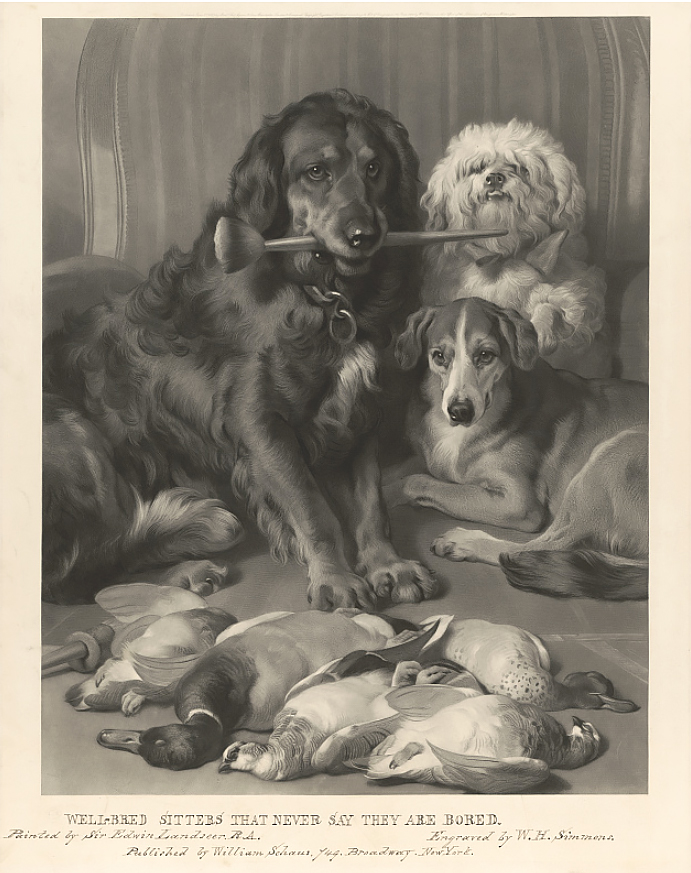Well-Bred Sitters Who Never Say They are Bored (1864)
by
Sir Edwin Landseer
The large dog at center-left, holding a paintbrush in its mouth, is identified as a Newfoundland in an 1864 newspaper article (see below) reviewing the art exhibition which included this painting; the same dog is identified as a "retriever" in the description of a mezzotint of this painting owned by the Royal Collection Trust, the agency of the British Monarchy responsible for managing the royal collection of art.

(etching of Landseer's painting by W. H. Simmons)

On February 11, 1864, The Times (London) published a review of an art exhibition held at The British Institution, a private art society which existed from 1805 to 1867.
This 1864 exhibit clearly did not impress the reviewer for The Times, whose review begins thus:
It is fortunate that the critic is not compelled to gauge either the aim or the achievement of contemporary English art by this exhibition; for taking its pictures as a whole, it is hard to say whether the lowness of the painters' aspirations or the imperfection of their work is most conspicuous. . . . The bulk of the pictures here are simply valueless, even if tested by a very low standard, whether as regards subject or execution.
Despite that dismal overall assessment, though, the reviewer does single out a few works for commendation, among them Sir Edwin Landseer's "Well-Bred Sitters," about which he has this to say:
It is a more agreeable and useful duty to pause upon the few examples of good work that leaven the lump of poor and bad art here offered to the public. First and foremost stands the picture by Sir Edwin Landseer (68), "Well-bred sitters that never say they are bored" — a group, including a noble black Newfoundland, a sagacious beagle, a leash of dead ptarmigan, and a cock pheasant, with the accompaniments of a cigar-box and half-emptied cigar case, a painter's oil-jar, and a couple of brushes. Sir Edwin shows no decay of power in any part of this picture, whether we look at the general agreeableness of the arrangement, at the heads or coats of the dogs, the soft feathery texture and admirable coloring of his birds, or the facile and faithful rendering of the accessories. The badger-hair brush in the Newfoundland's mouth is an excellent example of this master's swift and simple mastery in expressing certain textures by means of his own devising, giving a result exactly like the thing represented, but in a manner quite unlike any other painter's. The dogs are dogs au natural, not dogs travestied into men, and Sir Edwin, like all great animal painters, is best when he avoids such devices. It is some time since we have seen so equal and finished a work from the hand of this admirable master.
I confess to being a bit puzzled by some of the reviewer's statements. I'm not convinced that the "beagle" is actually a beagle, not do I see any sign of the cigar box, cigar case, or the painter's oil-jar mentioned in the review, although it is not impossible that those were cropped out of the images of this work I have so far been able to find. It is also the case that this would not be the first review of a Landseer work which erred in identifying some of the painting's elements; see, for example, the well-known critic John Ruskin's comments on Landseer's classic work The Old Shepherd's Chief Mourner.



